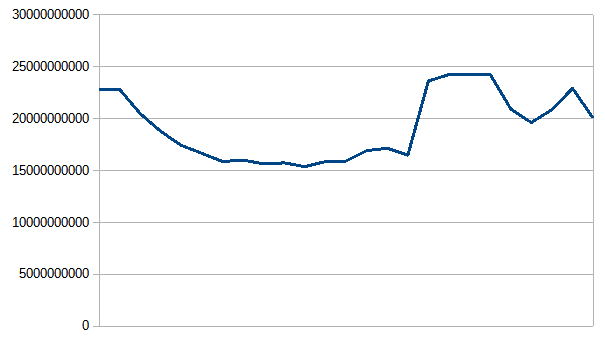RFR: 8290025: Remove the Sweeper
Erik Österlund
eosterlund at openjdk.org
Thu Aug 4 20:24:39 UTC 2022
On Thu, 4 Aug 2022 15:35:29 GMT, Boris Ulasevich <bulasevich at openjdk.org> wrote:
> > I would be interested in seeing what the graph looks like with my current proposed change. I don't know what state my prototype was in when you performed measurements, and the heuristics have been tweaked.
>
> Below is a CodeCache chart (numbers from -Xlog:codecache this time) on the current proposed change. App gets 250MB of CodeCache, and executes 23 independent benchmarks.
>
> 
>
> > Was there a regression due to unloading perceivably cold code?
>
> No, specific of my run is a set of independent benchmarks: warmup, iteration, warmup, iteration - it does not get regression unless the CodeHeap is completely over. Sweeper itself does not affect performance, I checked it. My concern is about user applications.
>
> > Having said that, if half the code cache was filled up, it sounds like it's getting to a point where you do want to flush things that haven't been used in a long while, to avoid getting into the "red zone" of aggressive sweeping at 90%, in order to free up space for currently hot code. To me it looks like it is working kind of as expected.
>
> In my picture, we can see that the methods are swept out when the CodeCache is 70% free. For me it is not expected. Even a super-cold method can come back. We should not flush it when we are far from memory starvation.
1) It isn't obvious based on the chart that my new strategy unloads more nmethods due to being cold, than we did before. The sweeper before would make nmethods not_entrant in one cycle, but might need 4 cycles to actually be able to delete them. That means that the previous approach had much more floating garbage in the code cache, but that doesn't necessarily imply that the number of nuked nmethods were smaller. The new approach is much more effective and can do all the things necessary to detect cold nmethods and unload them from the code cache, in a single cycle, which immediately brings down the code cache size. It still might be that my new algorithm is more aggressive, but the data does not conclude that.
2) The UseCodeCacheFlushing flag is on by default. Its assumption is that you want to "Remove cold/old nmethods from the code cache". Based on what you are saying, it sounds more like we shouldn't do that at all for some applications where you want super cold nmethods to still be around. I guess this flag can be turned off then, if you have such an application.
Note though that if the application for example idles, then there is no allocation rate in the code cache, and my new heuristics won't remove anything, because it is based on how long until the code cache becomes "too full", given the current allocation rate (which is likely 0 when idling), while the old heuristics have been reported to reap the entire code cache in such situations.
-------------
PR: https://git.openjdk.org/jdk/pull/9741
More information about the hotspot-dev
mailing list